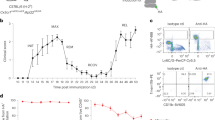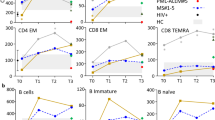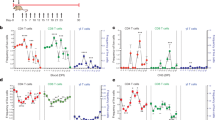Abstract
The cardinal pathological feature of multiple sclerosis (MS) is the presence within brain and spinal cord of regions called plaques, from which myelin has been lost1. It has been proposed that autoimmunity may be involved in MS and that oligodendrocytes, the cells responsible for the formation and maintenance of central nervous system myelin, may provide a target for immune attack in this disease. The fact that oligodendrocytes are reduced in number in MS plaques2 is consistent with this hypothesis. MS is characterized by attacks and remissions. During attacks, a subset of T lymphocytes, known as T suppressor cells, is depleted from the circulation3–5. The reason for this depletion is unknown, but the suppressor cells could be destroyed, sequestered, for example in brain, or modulated so that they are no longer detectable by the assays which enumerate them or which measure their functional capacities. Were suppressor cells and oligodendrocytes to share a determinant relevant to MS, both cell types could be targets for immune-mediated killing by the same autoimmune response. Recently, monoclonal antibodies which recognize human monocytes, T lymphocytes and T-cell subsets have become available. We have tested cultured ovine oligodendrocytes with a battery of monoclonal antibodies directed against human lymphocyte and monocyte antigens, seeking evidence for shared determinants, and present here data suggesting that shared determinants exist.
This is a preview of subscription content, access via your institution
Access options
Subscribe to this journal
Receive 51 print issues and online access
$199.00 per year
only $3.90 per issue
Buy this article
- Purchase on Springer Link
- Instant access to full article PDF
Prices may be subject to local taxes which are calculated during checkout
Similar content being viewed by others
References
Charcot, J. M. Gaz. Hoâp. Paris 41, 554–566 (1868).
McAlpine, D., Compston, N. D. & Lumsden, C. E. (eds) Multiple Sclerosis (Livingston, Edinburgh, 1955).
Antel, J. P., Arnason, B. G. W. & Medof, M. E. Ann. Neurol. 5, 338–342 (1979).
Reinherz, E. L. et al. New Engl. J. Med. 303, 125–129 (1980).
Bach, M. A. et al. Lancet ii, 1221–1222 (1980).
Reinherz, E. L., Kung, P. C., Goldstein, G. & Scholossman, S. F. J. Immun. 124, 3, 1301–1307 (1980).
Szuchet, S., Arnason, B. G. W. & Polak, P. J. J. Neurosci. Meth. 3, 7–19 (1980).
Szuchet, S. & Stefansson, K. Adv. cell. Neurobiol. 1, 313–346 (1980).
Szuchet, S., Stefansson, K., Wollmann, R. L., Dawson, G. & Arnason, B. G. W. Brain Res. 200, 151–164 (1980).
Goust, J. M., Banik, N., Bethea, A. & Sullivan, L. M. Trans. Am. Neurol. A (in the press).
Ma, B. I., Joseph, B., Walsh, M., Potuim, P. F. & Tourtellotte, W. W. Ann. Neurol. 9, 371–377 (1981).
Diamond, B. & Scharff, M. D. J. Immun. 125, 631–634 (1980).
Boyum, A. Scand. J. clin. Lab. Invest. 21, Suppl. 97, 77–89 (1968).
Greenwalt, T. S., Gajewskki, M. & MacKenna, J. L. Transfusion 2, 221–229 (1962).
Author information
Authors and Affiliations
Rights and permissions
About this article
Cite this article
Oger, J., Szuchet, S., Antel, J. et al. A monoclonal antibody against human T suppressor lymphocytes binds specifically to the surface of cultured oligodendrocytes. Nature 295, 66–68 (1982). https://doi.org/10.1038/295066a0
Received:
Accepted:
Issue Date:
DOI: https://doi.org/10.1038/295066a0
This article is cited by
-
Presence of T-cell subset abnormalities in newly diagnosed cases of multiple sclerosis and relationship with short-term clinical activity
Journal of Neurology (1993)
-
CSF T-cell subsets in multiple sclerosis: Relationship to cerebrospinal fluid myelin basic protein and clinical activity
Journal of Neurology (1989)
-
Neural repair in an insect central nervous system: cell kinetics and proliferation after selective glial disruption
Cell and Tissue Research (1987)
-
Elevated levels of a glycoprotein antigen (P-80) in gray and white matter of brain from victims of multiple sclerosis
Neurochemical Research (1986)
-
Blood lymphocyte subsets in patients with primary intracranial tumours. Correlation to histological tumour type and anatomical site
Acta Neurochirurgica (1986)
Comments
By submitting a comment you agree to abide by our Terms and Community Guidelines. If you find something abusive or that does not comply with our terms or guidelines please flag it as inappropriate.



